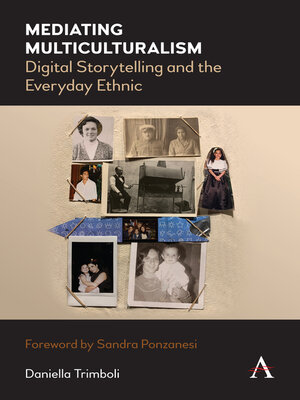Mediating Multiculturalism
ebook ∣ Digital Storytelling and the Everyday Ethnic · Anthem Series in Citizenship and National Identities
By Daniella Trimboli

Sign up to save your library
With an OverDrive account, you can save your favorite libraries for at-a-glance information about availability. Find out more about OverDrive accounts.
Find this title in Libby, the library reading app by OverDrive.



Search for a digital library with this title
Title found at these libraries:
| Library Name | Distance |
|---|---|
| Loading... |
Using digital storytelling—a new media genre that began in California in the late 1990s and that proliferated across 'the West' in the 2000s—as a site of analysis, this book asks, 'What is done in the name of the everyday?' Like everyday multiculturalism, digital storytelling is promoted as an accessible, enabling, and ordinary phenomenon that represents cultural experience more accurately than official sites. As such, the genre frequently houses stories of migration, community, and ethnic and racial differences. In turn, digital story collections often act as digital monuments or repositories of multiculturalism, giving a digital life to narratives of migration, cultural difference, and national belonging. This is evidenced in one of the world's largest public collections of digital stories, found in the Australian Centre for the Moving Image (ACMI) and referenced throughout this book.
Using examples from this collection and pointing to comparable ones in the UK and North America, this book investigates how notions of the everyday become a channel through which certain long-standing discourses of race get redeployed in multicultural nations. What can digital storytelling teach us about the status and future of multiculturalism in these societies? Can digital storytelling re-mediate multiculturalism in new, progressive ways?
|Multiculturalism has been a topic of scholarly exploration for almost fifty years. Most recently, these explorations have sought to respond to growing public sentiment that the multicultural ideal, borne out of Western liberalism, has failed. Indeed, 'multiculturalism is dead' has been a popular catch cry in Anglo- and Western-European countries for the past decade. Significantly, the continued discussion about the success or otherwise of multiculturalism registers the topic as alive as ever (albeit in a mode of crisis) and one that shows no signs of disappearing.
There are currently two main scholarly approaches to the so-called crisis of multiculturalism. The first approach retains the importance of multiculturalism by inflating and promoting its positive attributes. The second approach problematizes multiculturalism by retexturing its meaning and attempting to reconnect its political/theoretical domain with its ordinary manifestations. In some instances, the second approach renounces the concept of multiculturalism altogether, positioning it as a past phenomenon. Both approaches frequently mirror broader trends in cultural studies and artistic domains by turning to 'the everyday', using on-the-ground experiences as a tool to redefine the meaning of multiculturalism. But what work is done in the name of the everyday? Is 'the everyday' really a sanctioned, authentic space where cultural difference exists beyond the State? These are questions that neither approach takes seriously nor appropriately addresses.
This modern book addresses this oversight by taking the everyday of everyday multiculturalism to task and doing so via the increasingly popular and everyday medium: digital storytelling. The 'digital' is an important node of analysis, not only because it has so far been overlooked in studies of everyday multiculturalism, but because its immateriality often affords it a distance from critical analyses pertaining to material effects. This book forefronts the materiality of digital storytelling by closely considering how the genre enables racialization to manifest at the level of the body. How does the genre compel the creators of digital stories to embody and/or reject racialized structures associated with concepts of multiculturalism? What do these stories tell us about the way...







